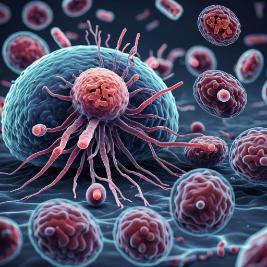
Photodynamic therapy (PDT) is an exciting new approach to cancer diagnosis and treatment, using a combination of oxygen, laser light and a photosensitizer. PDT may be thought of as specialized form of chemotherapy in which the drug (the photosenstitizer) is harmless by itself, but gets activated in the presence of molecular oxygen on exposure to light. It is thus a localized form of treatment which does not have the side effects of chemotherapy. Current evidence suggests that PDT has the potential to be widely applicable to a wide range of human cancers. Porphyrin photonsitizers have been tested for use in many cancers such as lung and bladder. However, many of the drugs based on porphyrins have limitations, such as localization in healthy tissue and irreproducible synthesis. Also, porphyrin photosensitizers are absorbed in the UV region where tissue penetration by light is minimal. The synthesis of new drugs that are absorbed in the visible and near IR regions will allow for the treatment of thicker tumours. Thus the aim is to study metallophthalocyanines and related molecules as photosensitizers for PDT.
Recent advances in the treatment of tumours are towards the synthesis of bi-functional agents that allow the combined action of PDT and hyperthermia. This is expected to result in tumour damaging based on both heat dissipation (HPT) and light photosensitization (PDT). HPT increases the cellular uptake of oxygen, since the heating up of the cell causes dilation which allows free flow of oxygenated blood to the cells. This is essential for PDT, where ground state oxygen is needed to produce cytotoxic derivatives of oxygen. uptake of phthalocyanines in tumours may help localize the magnetic particles (used for HPT) in tumours, if the two (phthalocyanines and magnetic particles) are connected together. Magnetic particles produce heat through various kinds of energy losses during application of an external AC magnetic field. If magnetic particles can be accumulated only in the tumour tissue, cancer specific heating is available.
MPc-PDT agents will also be combined with quantum dots (QDs), which are nanoparticles of for example CdSe that absorb and then re-emit light, hence can be used in locating cancers. The combination of PDT, HPT and QDs allows for an efficient cancer treatment involving photosensitization (PDT), heat treatment (HPT) and imaging QDs.
The project involves (i) the synthesis of novel phthalocyanine molecules for PDT, (ii) the study of their photochemical and photophysical properties using state-of-art laser flash photolysis equipment and (iii) the study of the behaviour of the selected drugs on cancer The preferential cells. The novel phthalocyanine materials will then be combined with nanoparticles of magnetic fluids (iron oxide) for use in combination PDT-HPT. The novel phthalocyanine materials will also be combined with surface fuctionalised quantum dots (e.g. CdSe).
The photophysical and photochemical properties of MPc combined with QDs or HPT agents will be studied. The complexes will then be studied in cells in collaboration with Prof Chen (China).
Last Modified: Thu, 27 Jun 2024 09:27:19 SAST